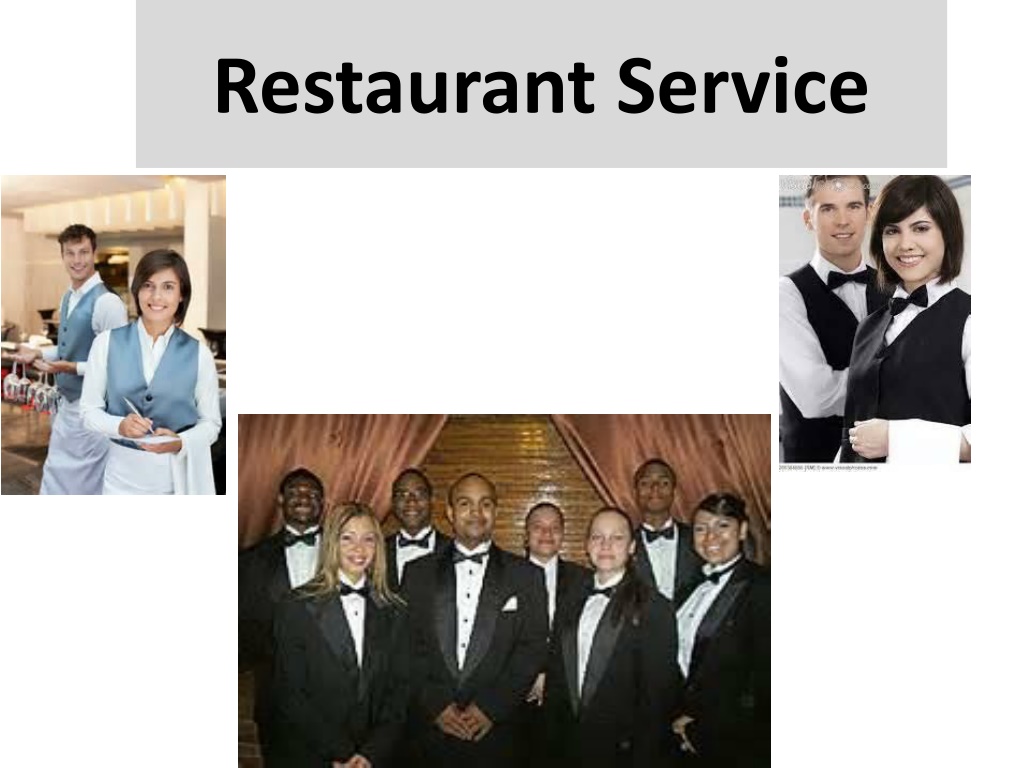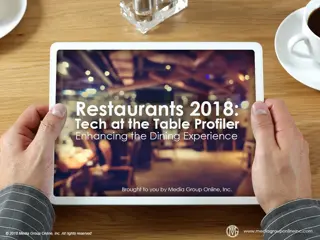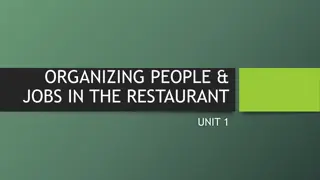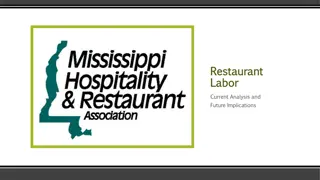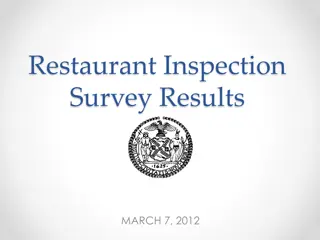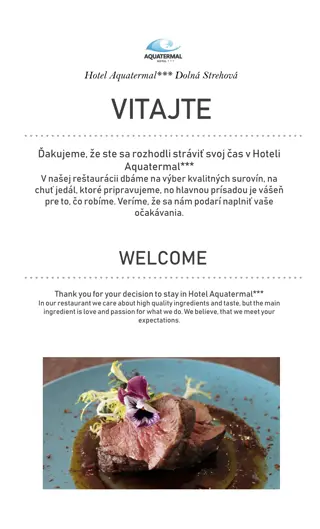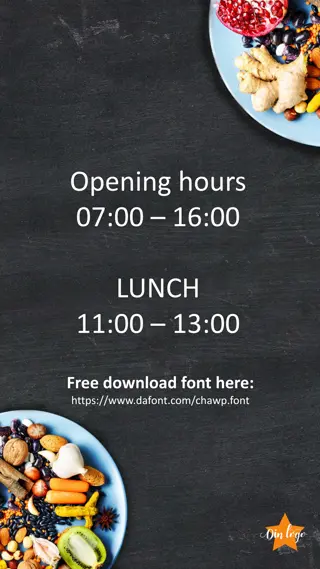Effective Restaurant Service Tips
Understanding the importance of courtesy, different types of waiters to avoid, focusing on being a confident and purposeful waiter, emphasizing posture and body language, and handling reservations and table allocations efficiently are key aspects of providing exceptional restaurant service.
Download Presentation

Please find below an Image/Link to download the presentation.
The content on the website is provided AS IS for your information and personal use only. It may not be sold, licensed, or shared on other websites without obtaining consent from the author. Download presentation by click this link. If you encounter any issues during the download, it is possible that the publisher has removed the file from their server.
E N D
Presentation Transcript
Courtesy is one of the most essential aspects of restaurant service, so is a degree of formality, especially in up market operations. Efforts must be made to ensure a relaxed and welcoming atmosphere with a warm, friendly and efficient service provided with politeness.
Types of Waiter 1. The Running Waiter: Running waiters give the guests the impression that cannot cope with their work and that they are not in control. Don t be a running waiter. A sense of - urgency: yes. An impression of panic: no. 2. The Slouching ( Lazy way of standing ) Waiter: When things are slow in your dining area you must never lean or slouch. This body language tells your guests you are not really interested in them. There is an old Food Service saying when work is lean it s time to clean. There are always things to be cleaned in a service area.
3. The Confident Waiter: This is you. You know what you are doing; you have a job to do and you know how to do it. Your movement is purposeful: if you go to the kitchen you are going for a reason. Not just appear busy
POSTURE AND BODY LANGUAGE A good posture is critical to building guest confidence, always be conscious of how you look to the guest. If you are unsure of your posture, look in the mirror or ask your workmates, walk tells guest a lot about you. Walking in the restaurant is important. It is done at a brisk pace giving guests the impression of confidence and purpose.
Handling Reservation & Allocation of tables Following points must be noted down while taking down a reservation 1. Name of the guest 2. No. of pax 3. Time of reservation 4. Contact number and name of the booker 5. Any special request/ requirement/ table preference. i. Reservations of the day are discussed during briefing prior to meal period; allocation of the tables is done at this time. Allocation of table is done prior to arrival of the guest and a note of the same is made on the reservation register, so that 1. The guests can be seated on appropriate table, as per request or occasion. 2. All restaurant staff is aware of the same, thereby eliminating confusion and ensuring smooth and professional welcome. 3. Ensuring optimum seating levels in the restaurant. ii.
SEQUENCE OF SERVICE Sequence of service is referred to as the order or step by step procedure in which a waiter provides service to guests from the time the guest enters the restaurant to the time he leaves the restaurant. Preparation to deliver satisfied service begins before the guest steps into the restaurant with activities like m nage, handling reservation, allocation of table. Once the guest arrives in the restaurant there is a certain sequence that is followed to make his/ her meal experience pleasant.
Welcome the guest 1. As the guest enters a restaurant, he/ she must be greeted cordially and must be made to feel comfortable. 2. Usually this task is performed by the hostess of the restaurant, however, is not just restricted to her. 3. It is for each and every restaurant staff to see to it that the guest is greeted within 30 seconds of arriving in the restaurant.
2. Guest must be greeted with a clear and affable tone of voice, good appearance and a smile. Every guest must be welcomed with the greeting of the day. In ethnic restaurants, guest is greeted in the national/ regional greeting. Incase the restaurant staff is busy serving other guests, they must ensure that even though they may not be physically free to welcome guest, they must acknowledge their presence by a smile or a gesture to say We will be with you in a minute . Never ignore the guests. 3. 4.
Find out if the guest has a reservation. If yes, then escort them to their table and address them by their name, should they not be satisfied with the table then offer alternatives. If no, then ask them for their preference of table and escort them to the table. Guest should be led to their table, if there is a gesture towards the table, it must be done with open palm facing upwards rather than pointing a finger on to the table.
Seating the guest It is guests prerogative to choose where they want to sit or where their host would like them to sit. Ladies must be seated first. Seating the guest on a chair 1. Stand straight 9-12 behind the guests chair. 2. Bring the right foot forward, with the knee touching the wooden skirting of the seat in the middle. 3. Hold the chair from both the hands from the sides of the back. Lift the chair about 1 from behind and pull it back, ensuring 4. that there is adequate space for the guests to go between the table and chair. 5. When the guest proceeds to sit down, move the chair slowly towards the guest, till it is comfortable for the guest and rest the chair of the floor. 6. It must be ensured that the chair is not dragged.
Acknowledge the client Before being seated, every guest should be acknowledged by all floor personnel passing by, even when waiters are carrying trays at the time. Nothing upsets the customer more than feeling ignored.
Donts while seating a guest 1. Seat gents before ladies. Rapid movement of chair. 2. Incorrect handling of chair. Ordering guests where to sit. 3. Show irritation due to indecisiveness of guests, as to where to sit. 4. If there are empty chairs on the table, the guests are asked if they are going to be joined by more people. If not then extra covers are removed. 5. Once the guests are seated, napkin must be unfolded from the left hand side and placed on guests lap without touching the guest and ensuring that the arm is away from the guests face.
Pouring water As soon as the guests are seated, waiter must pour water. Guests must be asked for their preference of water (regular, mineral, aerated, spring water) Wile pouring water following points must be kept in mind: Regular water poured from a water jug Jug should be clean with sufficient water for number of people on the table. Should be cold and room temperature as per guest s requirement. Should be carried on an underliner or with a waiters cloth neatly folded to ensure that the condensed water does not drip on the table. Water must be served from right hand side, ladies must be served first. Glasses must only be refilled when they are two-thirds empty
Mineral water poured from the bottle Seal must be opened in front of the guest. Should be carried in a cane basket and after pouring can be placed back on the table. However, must be ensured that the service of water is done by the staff and not be the guests themselves. Guests must be checked with, before opening a new bottle.
Provide Table service Welcome each guest at your station. Pull chairs for all guests. Bread and butter should be placed on the table as soon as the drink order is taken, and replenished as soon as the bread and butter are consumed. As beverages or water are consumed, refill and take orders for additional beverages.
Menu presentation 1. Present individual menu cards to the guests. 2. Menu card must be presented from the right hand side, open to the first page. 3. Give 5-7 minutes to the guests to go through the menu. 4. Check with the guests if they are ready to place the order, by inquiring May I take your order Sir/ Madam or Are you ready to place your order Sir/ Madam ? 5. Stand straight at a position where it is convenient to talk to the guests. 6. Assist the guest in choosing the best dish on offer, use suggestive selling or up selling techniques. 7. Take down the order systematically on KOT (Kitchen Order Ticket) 8. After taking order, repeat the order. 9. Take menu card back from the guests and put it back in place. 10. Inform the guests of the approximate time it would take to serve the food.
Order taking Aperitif card must be presented to take drink order prior to presenting food menu. Unless the food has been pre-ordered, as soon as the guests are seated, they must be presented with the menu card
Be knowledgeable The captain or waiter taking the order should be able to describe every item on the menu. He/she should know what it looks like, the recipe, the taste, and the method of preparation. Know the history, statistics and geography of the establishment. He/she also should know the basic eating customs of different cultures.
Move gracefully The need for the servers not to be clumsy in a dining room is of such magnitude that in exclusive restaurants like a three-Michelin star restaurant in New York, Monte Carlo and Paris, the owner hires a choreographer to teach the waiters how to move with grace.
Be discreet Do your chores swiftly, without interrupting and asking for permission, just smile. Do not interrupt a discussion between guests to state your opinion. Answer only if asked by the guest.
8. Use an unde- liner For everything brought to the table except china, use an under-liner. A beverage tray for glasses, a lined caddy for the condiments, a lined plate for silverware or a tray for the coffee cups and saucers, etc.
9. Service with Teamwork Help your co-worker today and you will get help when you need it. 10. Anticipate and be discreet During service servers should try to be almost invisible. Address the guest for specific tasks only, such as when taking orders, serving food and beverage, and collecting the check. Take care of maintenance procedures, re-fill glasses, replace ashtrays, replace silverware and clear the soiled dishes while being as unobtrusive as possible and checking guest satisfaction.
Service of Food and Beverage orders 1. Beverages are served first. Always serve beverages from the right of the guest. While the guests are waiting for their meal, bread and butter must be served immediately. Waiting staff must ensure that the same is replenished as soon as it is over. The guest should not have to ask for it. Before serving the food the waiters must ensure that the cover is appropriate, should it need to be changed then it must be done before the food comes to the table. This must be done discreetly, ensuring minimum intrusion and disturbance to guest and with minimum cluttering. Food order must be announced before the service. 2. 3. 4. 5.
Sequence of serving guest is as following: 1. Guest of honor is served first. 2. A lady in the party takes precedence over the male guest of honor. 3. Ladies must be served before Gentlemen. 4. Older people are served before younger ones. 5. Host must be served last. 6. Service of food: a) Pre-plated service of food must be from the right hand side. Once the food is placed the covers must be adjusted if the tableware is disturbed. b) Platter to plate or silver service must be from the left hand side. c) Service of each course should be co-ordinated in a manner that the guests do not have to wait for a long time between the courses.
h) Guest must be asked whether the food is up to their expectation. It must not happen that in enthusiasm, 3-4 people go to guest to ask if every thing is alright ! This may irritate the guest and may be an intrusion in his privacy. i) Water and other food items must be served/ replenished as soon as it is over. j) Before removing anything from the tale, seek guest s permission.
Clearance 1. 2. Used plates are cleared from the right hand side. Plates are cleared after all the guests on the table have finished their meal. Indication for closing the meal is done by placing knife and fork together across the plate. Clearance is done by right hand and collected on the left hand, by the first plate technique. Ensure that all the dishes are cleared from the table. Ensure that that cruet set, butter dish, bread boat, cutlery unused by guest is removed from the table. Do not remove bud vase ashtray and glasses from the table. All dirties should be taken for dish washing except cruet set, which must be left on the side station. 3. 4. 5.
Crumbing 1. Crumbing is done to remove spills or crumbs on the table after a course or after the main course, prior to dessert being served. 2. Carried out by a crumbing spade, crumbing brush or on a B&B plate with a waiters cloth and a B&B knife to pick up gravies that might have fallen on the tablecloth. 3. Begin crumbing from the left hand side, holding plate on left hand just under the tabletop; gently sweep the crumbs on to the plate. 4. Open the dessertspoon and dessert fork. 5. Bad stains can be covered with a clean white napkin.
Dessert order/ Tea Coffee Order Similar procedure as order taking A waiter can take the opportunity to suggest Liqueurs or and other digestive as this time.
Presenting check Checks must be presented only when asked. Waiter must bring the check in a neat and tidy folder. Guest comment card should be in the folder. A pen must be given along with the check folder. When the guest is leaving the folder must be removed very discreetly. Tips must never be solicited.
Farewell This is as crucial as welcoming the guest. Guest must be helped in getting up by pulling out the chair for them. Should be assisted with coats/ shawls. Must be thanked. Must be welcomed again .. Look forward to welcoming you back to the restaurant , We hope that you visit us soon
SEQUENCE OF TABLE SERVICE (A LA CARTE SERVICE) 1. Welcome/greeting the guests 2. Escorting guests to their tables 3. Seating the guests 4. Offering Before Dinner Drinks 5. Serving of Drinks/water 6. Presenting the Menu and Taking the Order 7. Placing order to the kitchen 8. Completing the table set-up 9. Picking up/ assembling the order 10. Serving food according to standard Sequence 11. 1st - Bread and Butter 12. 2nd - Appetizers 13. 3rd - Soup 14. 4th - Salad 15. 5th - Main Course 16. Clearing of Table after every finished Course 17. Offering and serving dessert 18. Offering/Serving after-Dinner Drinks/Coffee 19. Preparing/Setting of Guest Check 20. Bidding Good-bye and thanking the Guest .All staff
SEQUENCE OF DINING SERVICE A LA CARTE FINE DINING WITH WINE SERVICE 1. 2. 3. 4. 5. 6. 7. 8. 9. 10. Clearing of aperitif glasses 11. Presenting and serving white wine 12. Serving appetizers, then soup 13. Cleaning of soiled dishes 14. Presenting and serving red wine 15. Serving the main course and side salad 16. Refilling red wine glass 17. Clearing red wine glass 18. Clearing soiled dishes, crumbing down of tables 19. Offering and serving dessert 20. Offering sweet cherries/sweet champagne 21. Offering/serving coffee and liqueurs 22. Presenting and setting the bill 23. Bidding goodbye/thanking the guest .. Welcoming / greeting the guests Offering Before-Dinner Drinks (aperitifs) Serving or Bread and butter Presenting the menu Serving before-dinner drinks (aperitifs) Taking of food order Placing/picking up food orders Taking wine order Completing the table-set-up All staff
DOs 1. Acknowledge the guest Smile 2. Answer all customers questions 3. Pull chairs when customers seat 4. down or get up to leave 5. Give directions to the guests 6. Act dignified, be proud 7. Be polite and helpful 8. Place silverware on the table before 9. food is served 10. Ask for help when needed 11. Ask the guest to repeat the order in 12. case you have missed something 13. Look healthy and well groomed 14. Perform your duties gracefully
15. Place yourself in such a way that you 16. can observe your tables 17. Prevent complaints 18. Anticipate customer's needs 19. Offer suggestions when asked 20. Treat bad tippers with same courtesy 21. generous customers 22. Carry on you: matches, pen, crumber 23. and wine opener, at all times 24. Take food back immediately if guest 25. did not like it 26. Treat customers as you would like to you be treated 27. Ask customers to come back
DON'T 1. 2. 3. 4. 5. 6. 7. 8. 9. 10. Argue with the guest 11. Go in any direction with empty hands 12. Leave your station unattended, even in an emergency without telling the supervisor 13. Congregate in groups more than two at the time Address guests but as Sir or Madam Be moody Comb your hair or touch your face Lean on walls or posts Talk loudly Put hands in your pockets Sneeze or cough Comment about the customers Leave your tables from your sight
Dont 14. Show visible effort or stress yourself when performing your duties. 15. Let customers look around for somebody or something and not check. 16. Complaint about your job or the establishment to the guests. 17. Never ask who gets what, when you approach the table with food. 18. Serve coffee without sugar, teaspoon and cream already on the table. 19. Present to the guest a plate of food your self would not eat. 20. Be flirtatious
sideboard (or dummy waiter) is a piece of furniture with shelves and cupboards, spacious enough to hold all linen, cutlery, crockery, and etc. for service to a particular number of coves. The smooth functioning of service in the given covers will depend on how thoroughly the sideboard has been prepared. Before a restaurant opens the sideboard must be equipped with the following items:
1. 2. Cold water in jugs with under plates and napkins to cover All-important preparatory sauces, such as Worcestershire sauces, Tabasco sauces, tomato ketchup, Maggi sauce, JP/HP sauces (The waiter should ensure that the necks of the bottles are cleaned). Toothpicks in toothpick holders Sugar bowls- for both brown and white sugar with teaspoons for each. Sugar dredger. Hot plates and order taking pads. Straw holders. Bread-boats or baskets with assortment of rolls and sticks. Ashtrays-cleaned and polished. 10. Service spoons and forks. 11. Adequate numbers of cutlery used on the table (normally two and a half times the number required for one sitting in the station). 12. Salvers. ( tray for serving food) 3. 4. 5. 6. 7. 8. 9.
14. Under plates. 15. Half plates, quarter plates and large plates and saucers. 16. A crumbing plate. 17. Trays covered with a napkin for service. 18. Spare restaurant linen of all types (napkins tablecloths, waiter clothes, etc.) 19. Paper napkins and doyly papers. 20. Butter dishes. 21. Finger bowls. 22. Water goblets (bar glasses in case bar service is extended by the restaurant). 23. Pots for preserves are filled and kept ready. 24. Cloth napkins are folded and kept ready for service. 25. All usable silverware to be used in service to be polished. 26. Cruet sets cleaned and filled with salt and pepper. Fresh mustard filled in appropriate pots.
Cleanliness Hotels, restaurants, bars, banquets have a lot to gain and more to loose based on the degree of their cleanliness. An establishment with a well-deserved reputation of cleanliness will attract customers who will take any opportunity to recommend it to others. One of the most important considerations a customer will take into account when choosing a hotel or restaurant is cleanliness.
Salt and Pepper Shakers: Every week, these should be emptied and washed as an evening closing duty, preferably on separate nights. Turn them upside down to dry them overnight so that an opening server may fill them at the beginning of the following shift. Salt and pepper shakers should be filled and wiped off daily, making sure the caps are tight. If they are done daily they don t need rice.
Chinawares /Coffee Cups: Since these become stained from tea and coffee, they may need to be soaked in special stain removing chemicals available from the detergent suppliers. You can use a light vinegar solution. Bleach should not be used to remove the stains; it can scratch the enamel coating of the china, and eventually make the stains permanent.
Coffeepots: The pots used for serving coffee should be polished and clean at all times. Coffee oil residue on the inside may be removed either with special coffee stain remover, a mix of citric acid powder and hot water, or a vinegar solution. The brewing pots can be washed with soap and water, ice cubes and salt, or soaked with the stain remover. Proper rinsing is crucial to this process.
Coffee machine: Clean daily. Wash moving parts and soak overnight. Take apart and deep clean once every week.
